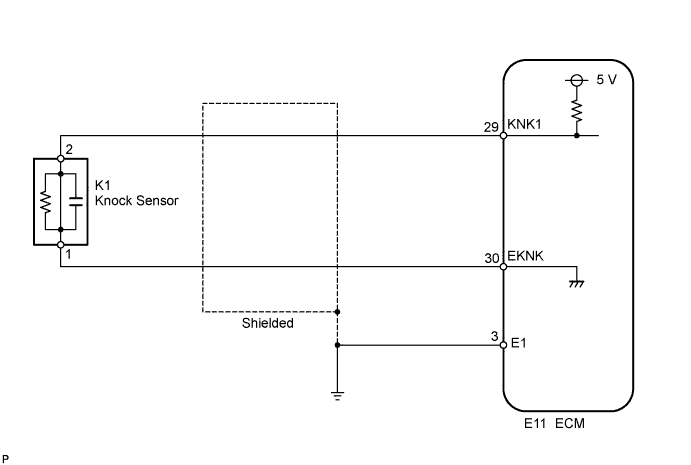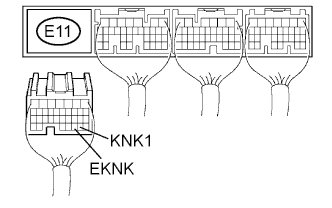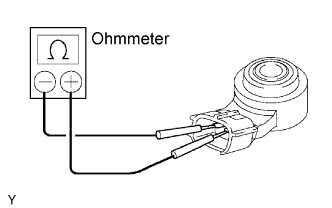Dtc P0327/52 Knock Sensor 1 Circuit Low Input (Bank 1 Or Single Sensor)
DESCRIPTION
MONITOR DESCRIPTION
WIRING DIAGRAM
INSPECTION PROCEDURE
CHECK HARNESS AND CONNECTOR (ECM - KNOCK SENSOR)
CHECK ECM (KNK1 VOLTAGE)
INSPECT KNOCK SENSOR
DTC P0327/52 Knock Sensor 1 Circuit Low Input (Bank 1 or Single Sensor) |
DTC P0328/52 Knock Sensor 1 Circuit High Input (Bank 1 or Single Sensor) |
DESCRIPTION
The flat type knock sensor (non-resonant type) has a structure that can detect vibrations from about 6 to 15 kHz and has the following features:- The knock sensor is fitted on the cylinder block to detect engine knocking.
- The sensor contains a piezoelectric element which generates voltage when it becomes deformed. This occurs when the cylinder block vibrates due to knocking. If engine knocking occurs, the ignition timing is retarded to suppress it.
DTC No.
| DTC Detection Condition
| Trouble Area
|
P0327/52
| Output voltage of the knock sensor is 0.5 V or less
| - Short in knock sensor circuit
- Knock sensor
- ECM
|
P0328/52
| Output voltage of the knock sensor is 4.5 V or more
| - Open in knock sensor circuit
- Knock sensor
- ECM
|
MONITOR DESCRIPTION
If the output signal remains low or high for more than 10 seconds, the ECM interprets this as a fault in the knock sensor and sets a DTC.The monitor for DTC P0327/52 and P0328/52 runs after the engine is started and 5 seconds have passed.
WIRING DIAGRAM
INSPECTION PROCEDURE
- HINT:
- Read freeze frame data using the intelligent tester. Freeze frame data records the engine conditions when malfunctions are detected. When troubleshooting, freeze frame data can help determine if the vehicle was moving or stationary, if the engine was warmed up or not, if the air-fuel ratio was lean or rich, and other data from the time the malfunction occurred.
| 1.CHECK HARNESS AND CONNECTOR (ECM - KNOCK SENSOR) |
Disconnect the E11 ECM connector.
Measure the resistance of the wire harness side connector.
- Standard resistance:
Tester Connection
| Condition
| Specified Condition
|
E11-29 (KNK1) - E11-30 (EKNK)
| 20°C (68°F)
| 120 to 280 kΩ
|
| 2.CHECK ECM (KNK1 VOLTAGE) |
Turn the ignition switch ON.
Measure the voltage of the ECM connector.
- Standard voltage:
Tester Connection
| Specified Condition
|
E11-29 (KNK1) - E11-30 (EKNK)
| 4.5 to 5.5 V
|
- HINT:
- Reference: Inspect using an oscilloscope.
- Check the waveform of the ECM connector.
- OK:
Tester Connection
| Specified Condition
|
E11-29 (KNK1) - E11-30 (EKNK)
| Correct waveform is as shown
|
Tool Setting
| Condition
|
0.01 to 10 V/Div., 0.01 to 10 msec./Div.
| After warming up engine, keep engine speed at 4,000 rpm
|
- NOTICE:
- Fault may be intermittent. Check the wire harness and connectors carefully.
| OK |
|
|
|
| CHECK FOR INTERMITTENT PROBLEMS |
|
Remove the sensor.
Measure the resistance of the sensor.
- Standard resistance:
Tester Connection
| Condition
| Specified Condition
|
1 - 2
| 20°C (68°F)
| 120 to 280 kΩ
|
| OK |
|
|
|
| REPAIR OR REPLACE HARNESS OR CONNECTOR |
|



